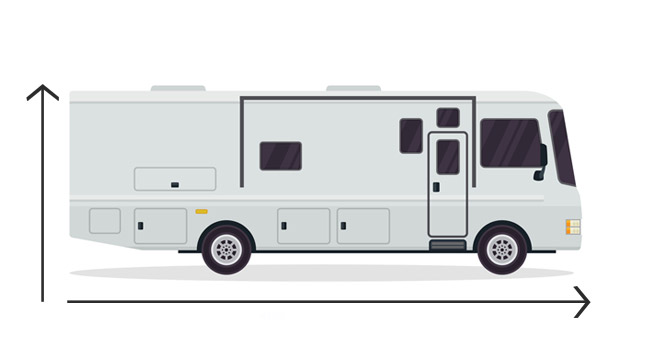Last Updated on February 23, 2022
Travel trailers can be a convenient way to take your family on vacation without spending a fortune. But when it comes to choosing a travel trailer for your desired camping destination, there are many things you need to consider first.
The most significant factor is measurement. It will help you figure out whether or not it will fit in your desired camping spot. But how do you know how are travel trailers measured or what size trailer is right for you?
With the appropriate trailer, your next road trip will be unique. With plenty of room for all your belongings, you can sleep comfortably on the road or at the campsite. Discover the most suitable trailer for your needs in our buying guide.
How are Travel Trailers Measured : Step by Step Guide
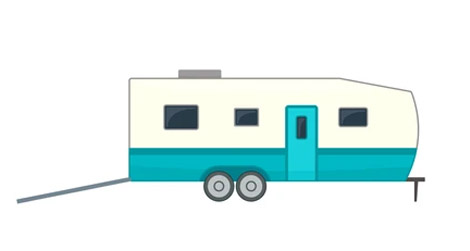
Travel trailers can be a lot of different sizes. It can be hard to know how they will fit into your driveway or campsite.
But sizes for travel trailers can be listed in terms of overall length (the brochures usually state the exterior length), overall width, and overall height.
With these pieces of information, you’ll be able to select the perfect trailer for your needs confidently. So,
Measure The Travel Trailer Length :
The travel trailer length is listed in feet. The measurement represents the distance from the front of the frame to the back.
You can measure the overall length of your travel trailer with a tape measure by doing the following:
- Stand in front of your trailer with your back against the hitch.
- Measure from the center of the hitch to the very end to the rear bumper of your travel trailer.
- Repeat this step for each side of the travel trailer.
This way, you’ll know the dimension of your travel trailer’s overall length. In addition, the cabin size of teardrop trailers is measured from the rear to the front of the cabin.
Measure The Width of Your Travel Trailer:
Width is designated by how many feet it takes up in the campground. When measured, it is listed as the distance between either side of your trailer, touching the ground and wall to wall.
So, you can measure this with a tape measure by doing the following:
- Stand in front of your trailer with your feet apart.
- Place the end of one side against your outside foot, reaching it as far as you can to touch the opposite wall.
- Measure from the floor up to the top of that wall (the door or window).
- Repeat on the other side and take the larger of the two measurements.
This way, you’ll know how wide your travel trailer is, which is important for packing up before leaving and parking it in campgrounds with limited spots. The typical width measurement is essential when traveling down narrow roads and on tight trails.
It can be helpful while determining how many items you will need to take with you and the amount of usable space/room it will take up in your automobile.
Measure The Height of Your Travel Trailer:
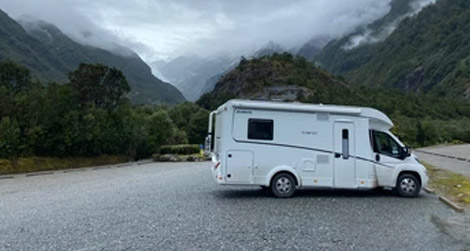
Height is measured from ground level to the top of the travel trailer. Like width, height is measured from ground level to the ceiling.
The measurement can be taken by measuring from the ground up one wall of your travel trailer and going across. You can do this by doing the following:
- Stand in front of your travel trailer with a tape measure and mark off where you will start to get an accurate measurement.
- Measure up the wall marking the distance between either your floor and ceiling or ground level, and puncture on the top of your travel trailer.
- Measure across to the opposite wall or ground level and mark it there as well.
- Repeat this process for the other side of your travel trailer and take the larger two measurements.
This way, you’ll know how tall your travel trailer is from ground level to ceiling, which will help you find a place to park and see if you can stand up inside.
If you have an extended hitch length for your tow vehicle, you may need to consider the height of the trailer to avoid scraping your roof when driving under low-hanging trees or other obstacles.
Factors to Consider When Choosing a Travel Trailer
Travel trailers are a great way to outfit your camping lifestyle. However, there are a couple of factors you should consider before purchasing:
Type of Camping:
It’s essential to look at where you will be camping and what amenities you may need for your camping experience. If you choose your travel trailer based on the type of camping you will be doing, it’ll be easy to determine what size is needed for your travels.
For example, if you’re someone who likes to camp at most national parks and other backcountry locations, then a small, lightweight model may fit best with your style of travel.
Total Length of Trailer:
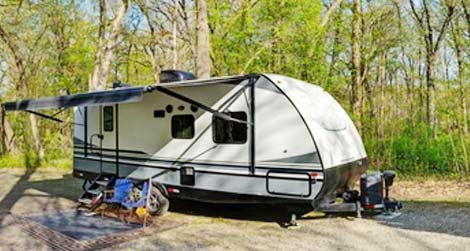
The total length of your travel trailer will help determine the type of automobile you should be towing it with. If you have a long-bed truck or SUV, many different kinds of trailers are available for your automobile.
On the other hand, if you have a small car or compact vehicle, consider looking into smaller travel trailers lighter and easier to tow.
Available Interior Length:
Travel trailers can be as small as 13 feet or as long as 41 feet. It’s essential to carefully measure your available interior length and develop a total layout of your living space before purchasing a travel trailer.
In some circumstances, you may need to make changes to fit everything into a smaller space. However, it may be best to wait until your travel trailer is set up before making any changes.
Available Interior Width:
It’s also essential to take a look at the width of your travel trailer. A more comprehensive, open floor plan is great for socializing and spending time with loved ones.
However, it may be more comfortable for some campers to have usable space to retreat into for some alone time.
Available Interior Hight:
Most travel trailers have a height of approximately 13’6″. However, it may be challenging to stand up at this height if you are over six feet tall. In these circumstances, you’ll need to look at the total height from ground level to the ceiling and make sure you can fit inside with ease.
Total Weight:
Ensure you can tow your travel trailer with ease, take a look at its total weight of it. The weight of your travel trailer will depend on the quality of its components and materials used during construction.
Slide-Out of Travel Trailer:
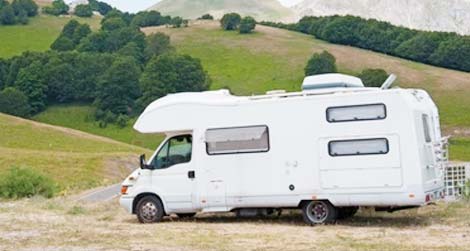
Slide-outs are a great addition to any travel trailer. They provide more interior living space, allow you to bring in more natural light, and increase the amount of storage you’ll have.
However, it’s important to remember that if your travel trailer doesn’t have slide-outs, this will save weight which is helpful when trying to tow it behind your towing vehicle.
Available Living space:
Many campers are there to spend time with their loved ones, so you must find a travel trailer that will allow everyone to spread out. Look for floor plans that have large dining areas and kitchen spaces.
Today, many newer trailers are being built with more flexible layout options, which helps give campers the chance to personalize their camping experience.
Trailer Hitch Length:
Most travel trailers will need a hitch rated to handle many pounds of weight. It’s important to make sure you have a trailer hitch installed that can handle your traveling unit’s weight.
However, some smaller units may come with a weight-distributing hitch system. This type of system reduces the weight on the towing vehicle and creates a smoother tow.
Your Travel Trailer’s Baseplate:
The baseplate of your travel trailer is its connection point with the towing vehicle. If you don’t have a large enough baseplate, you may need to upgrade before attempting to tow it.
There are many different types of baseplates ranging from essential to weight-distributing systems. Many high-end travel trailers come with their own modified baseplate system that can be installed without further modifications.
Length of the Trailer Tongue:
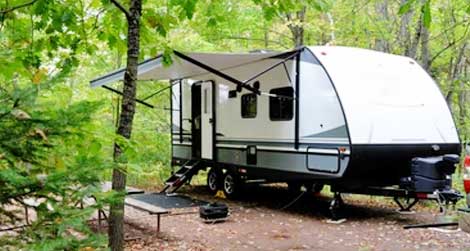
The tongue length of your travel trailer needs to match closely with your vehicle’s hitch. Different types of hitches have different lengths for tongues.
If your tongue is too short, you’ll have a difficult time securing your travel trailer to the hitch. If it’s too long, it will make it more difficult to back up and maneuver while trying to tow it.
Towing capacity:
Your travel trailer’s towing capacity will be shown in its manual. As a general rule, you should never tow a unit with more weight than what is recommended by the manufacturer.
Tips for Traveling With a Trailer
Once you have a travel trailer, it’s essential to take the proper steps to safely tow it behind your vehicle. Here are a few tips for safe and convenient road tripping:
- Always make sure your travel trailer is properly connected to your hitch. You’ll need to ensure the weight on both units is appropriately distributed between them to prevent damage.
- Consider using a weight-distributing hitch. These types of hitches help distribute the load across all your axles, allowing for a smoother towing experience.
- Ensure you have enough space between your vehicles for turning and backing up. This is especially important if you’re towing a larger travel trailer behind an RV or mobile home because they can be longer.
- Be sure not to exceed the travel trailer’s recommended weight limit, as this can cause damage to either storage unit.
- Before pulling out of your driveway, national parks, or campsite, make sure you are familiar with how you will back up and turn before doing so.
- Keep an eye on the weather and road conditions if you’re traveling through high heat or cold.
- Use common sense when driving with a travel trailer hooked up. Try avoiding sudden stops and sharp turns to prevent any damage from occurring.
- If you’re new to towing a travel trailer, take your time and practice in an empty parking lot.
- Make sure you aren’t towing through any flood areas or while there is heavy rainfall.
- Always keep your travel trailer maintained adequately while on the road, including regular oil changes and making repairs before they are needed.
You will efficiently and safely tow your travel trailer behind your vehicle by following these tips and instructions.
FAQs
Let us discuss some of the frequently asked questions regarding measuring travel trailers:
01. How are Bumper Pull campers Measured?
When measuring a Class A, B, or C motorhome, it is always done from the rear bumper to the front bumper. Measurements do not include ladders attached to the vehicle.
02. Does Trailer Length Include Hitch?

There is no mention of the tongue or hitch in the trailer’s length or manufacture description. The trailer’s length is determined by the box inside. It is imperative to consider the rear bumper, additions like a bike rack, as well as the tongue and hitch on the front of the trailer.
03. What is the Maximum Trailer Length for National Parks?
Almost 98% of National Park campgrounds are able to accept RVs up to 19 feet long. As long as your RV is up to 25 feet in length, you will still have numerous options because over 90% of campgrounds allow this length.
04. What are the Average Dimensions of a Travel Trailer?
The width of a trailer is generally 8 feet (or 96 inches). However, most light or compact travel trailers are between six and seven feet wide. Travel trailers never exceed 8.5 feet in width.
Final Words
For an unforgettable camping experience, it’s essential to consider how are travel trailers measured & your needs to make sure you have the correct travel trailer. Your location will determine what type of baseplate system you need and if a weight-distributing hitch is necessary.
Before making any decisions about which size or model fits your family best, research different types of trailers with all their features so that you can find the one that’s perfect for yours!
Once you’ve found the ideal unit for yourself, take these safety precautions when traveling with it on the road. With these tips in mind, first-timers should be able to tow their new travel trailer without hassle easily!

